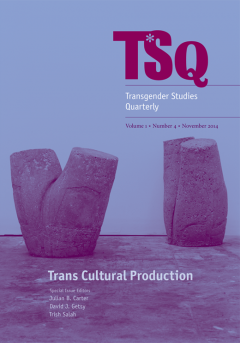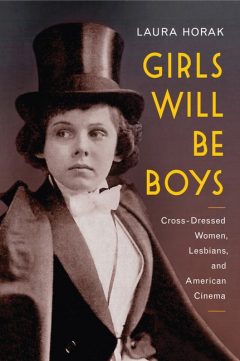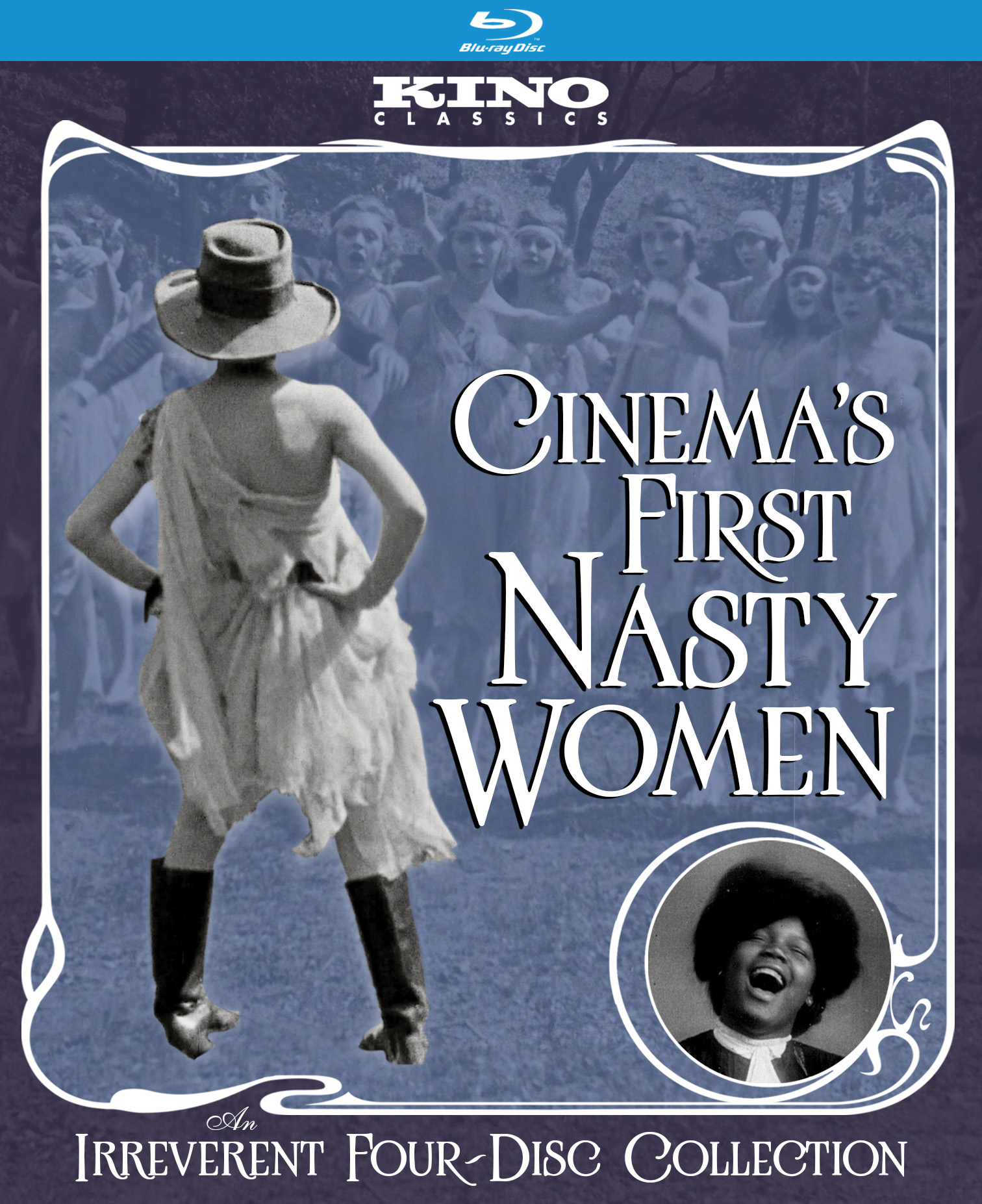
Laura Horak
Director of the Transgender Media Lab and the Transgender Media Portal; Professor of Film Studies
| Degrees: | BA (Yale University), MA and Ph.D. (UC-Berkeley) |
| Email: | laura.horak@carleton.ca |
Bio
Laura Horak is Professor of Film Studies at Carleton University and director of the Transgender Media Lab and Transgender Media Portal. She investigates the history of transgender and queer film and media in the United States, Canada, and Sweden. She is co-curator of the 99-film Bluray set Cinema’s First Nasty Women (Kino Lorber, 2022), author of Girls Will Be Boys: Cross-Dressing Women, Lesbians, and American Cinema (Rutgers 2016), and co-editor of Silent Cinema and the Politics of Space (Indiana 2014), Unwatchable (Rutgers 2019), Somatechnics 8.1 (2018) on trans/cinematic/bodies, a 2022 “In Focus” section of Journal of Cinema and Media Studies on transing cinema and media studies, and a 2024 issue of Reviews in Digital Humanities on trans and queer digital humanities. Horak is a white cis queer settler scholar who is here to leverage her privilege and institutional resources for the revolution.
Check out the newly launched Transgender Media Portal!
Cross-appointments and affiliations: Feminist Institute of Social Transformation; Communication and Media Studies; Institute for Comparative Studies in Literature, Art, and Culture; Collaborative Specialization in Digital Humanities; Sexuality Studies.
Laura Horak answers the question: Why study film?
Horak investigates how cinema has helped envision new forms of gender and sexuality, from the early twentieth century to today. With colleagues in the United States and Europe, she is establishing a new field at the intersection of transgender studies and cinema and media studies. Founder of the Transgender Media Lab, she is creating novel digital tools to connect scholarly work with marginalized communities and is bringing forgotten films to the public through international festivals, DVD releases, and streaming platforms.
Horak works in transgender studies, a discipline that centres the lived experiences and theories of transgender, Two-Spirit, nonbinary, intersex, and other gender-nonconforming people. With frequent collaborators Cáel M. Keegan and Eliza Steinbock, she is helping to establish a new subfield: trans cinema and media studies.
Horak publishes regularly on trans filmmaking practices.  Her article, “Trans on YouTube: Intimacy, Visibility, Temporality” (2014) has been cited in scholarship from a range of disciplines, in English, German, Swedish, Spanish, French, and Brazilian Portuguese. She argues that trans YouTube videos succeed because their formal strategies exploit the platform’s penchant for the personal and the spectacular.
Her article, “Trans on YouTube: Intimacy, Visibility, Temporality” (2014) has been cited in scholarship from a range of disciplines, in English, German, Swedish, Spanish, French, and Brazilian Portuguese. She argues that trans YouTube videos succeed because their formal strategies exploit the platform’s penchant for the personal and the spectacular.
Based on archival research in Toronto, Victoria, San Francisco, and Los Angeles, Horak has published on the hundred-year history of trans filmmaking in Canada and the US and the political, cultural, and aesthetic work of the world’s first trans film festivals. She is currently writing a book analyzing trans filmmaking in North America from the 1990s to today, Trans Cinema: An Introduction. She is also bringing attention to the works of trans filmmakers in Canadian film heritage as a collaborator on Janine Marchessault’s SSHRC Partnership Grant Archive/Counter-Archive and as an associate member of Susan Lord’s CFI-funded Vulnerable Media Lab.
Horak is building the field of trans cinema and media studies through a series of federally and provincially funded grants – a SSHRC Insight Development Grant (2017-2019), a SSHRC Insight Grant (2020-2025), and an Ontario Early Researcher Award (2019-2024). With this support, she has founded the Transgender Media Lab, a virtual and physical space for students and scholars working at the intersections of trans studies and media studies.
 Working from the framework of intersectional feminist digital humanities, Horak is creating new digital tools to connect her scholarship with diverse trans communities. A key project of the Transgender Media Lab is the Transgender Media Portal, a website that highlights the innovative work of trans filmmakers over the past half-century. The Portal enables new ways of analyzing trans film production and distribution and shares information with educators, students, festival programmers, artists, activists, and the public.
Working from the framework of intersectional feminist digital humanities, Horak is creating new digital tools to connect her scholarship with diverse trans communities. A key project of the Transgender Media Lab is the Transgender Media Portal, a website that highlights the innovative work of trans filmmakers over the past half-century. The Portal enables new ways of analyzing trans film production and distribution and shares information with educators, students, festival programmers, artists, activists, and the public.
 In addition to her work on trans-made cinema, Horak explores feminist, queer, and trans lessons of early twentieth-century cinema in the United States and Sweden and brings long-forgotten silent films to international publics. Horak’s monograph, Girls Will Be Boys, uses archival research to overturn long-standing assumptions about gender and sexuality in American film history, and reveals the fascination of early audiences with varied forms of female masculinity. Chosen by Huffington Post as one of the Best Film Books of 2016, it was also a 2016 Choice Outstanding Academic Title and a finalist for the 2016 Richard Wall Memorial Award by the Theatre Library Association in the US, and was longlisted for the 2016 Kraszna-Krausz Best Moving Image Book in the UK. Moreover, it has been cited in books and articles from a range of disciplines, in English, German, Swedish, Czech, and Spanish. Horak is writing a monograph titled Cinema’s Oscar Wilde (Rutgers UP) that demonstrates how cinema participated in the Swedish project of modernizing sexuality in the 1910s and 1920s via a case study of the gay, Jewish, Finnish-Swedish director Mauritz Stiller.
In addition to her work on trans-made cinema, Horak explores feminist, queer, and trans lessons of early twentieth-century cinema in the United States and Sweden and brings long-forgotten silent films to international publics. Horak’s monograph, Girls Will Be Boys, uses archival research to overturn long-standing assumptions about gender and sexuality in American film history, and reveals the fascination of early audiences with varied forms of female masculinity. Chosen by Huffington Post as one of the Best Film Books of 2016, it was also a 2016 Choice Outstanding Academic Title and a finalist for the 2016 Richard Wall Memorial Award by the Theatre Library Association in the US, and was longlisted for the 2016 Kraszna-Krausz Best Moving Image Book in the UK. Moreover, it has been cited in books and articles from a range of disciplines, in English, German, Swedish, Czech, and Spanish. Horak is writing a monograph titled Cinema’s Oscar Wilde (Rutgers UP) that demonstrates how cinema participated in the Swedish project of modernizing sexuality in the 1910s and 1920s via a case study of the gay, Jewish, Finnish-Swedish director Mauritz Stiller.
Horak brings the  results of her research to the public by programming feminist, queer, and trans silent films at film festivals in Italy, Sweden, and the United States. Through a SSHRC Partnership Development Grant (2020-2023) titled Cinema’s First Nasty Women, she collaborated with eleven film archives across Europe and North America, Kino Lorber, Le Giornate del Cinema Muto, and the Women Film Pioneers Project, to make 99 silent films featuring cross-dressing women and women comedians publicly available for the first time. The New York Times called the project a “mind-expanding endeavour” and “triumph of scholarship.”
results of her research to the public by programming feminist, queer, and trans silent films at film festivals in Italy, Sweden, and the United States. Through a SSHRC Partnership Development Grant (2020-2023) titled Cinema’s First Nasty Women, she collaborated with eleven film archives across Europe and North America, Kino Lorber, Le Giornate del Cinema Muto, and the Women Film Pioneers Project, to make 99 silent films featuring cross-dressing women and women comedians publicly available for the first time. The New York Times called the project a “mind-expanding endeavour” and “triumph of scholarship.”
Horak’s research demonstrates the key role of cinema in shaping the possibilities of gender and sexuality in our lives. Her scholarship is defined by international and interdisciplinary collaborations and, like cinema itself, her work brings people together across disciplines, national boundaries, and the academia/public divide to consider anew how media can reveal unexpected possibilities for more liberating ways of living our identities.
Videos
Developing Values & Putting Them Into Action: Building the Transgender Media Portal at Moving Trans History Forward Conference (September 2023).
PBS American Experience | Transcending Media: How Narrative Shapes Trans Lives (July 2023).
Cinema’s First Nasty Women at UCLA Film & Television Archive (September 2022)
Selected Publications
See all publications on Google Scholar
Special Issue on Queer and Trans Digital Humanities (open access). Reviews in Digital Humanities 5, no. 7 (July 2024). Co-edited with Constance Crompton.
“Guest Editor’s Note” (open access). Co-written with Constance Crompton. Reviews in Digital Humanities 5, no. 7 (July 2024).
Special issue on Curating Feminist Film Archives. Feminist Media Histories 10, no. 2-3 (Spring-Summer 2024). Co-edited with Maggie Hennefeld. 320 pp.
“Editor’s Introduction: Why We Curate Feminist Film Archives.” Co-written with Maggie Hennefeld. Feminist Media Histories 10 (2-3), 1-9.
“Feminist World-Making with Cinema’s First Nasty Women: A Roundtable with Neta Alexander, Kaveh Askari, Renée C. Baker, Jennifer Bean, Liza Black, Enrique Moreno Ceballos, Maggie Hennefeld, Laura Horak, Dana Reason, Elif Rongen-Kaynakçi, Kate Saccone, Aurore Spiers, Gonca Feride Varol, Yiman Wang, and Bret Wood.” Co-conducted with Maggie Hennefeld and Rachel Loewen. Feminist Media Histories 10 (2-3), 114-125.
“The Many Genders and Sexualities of American and European Silent Cinema.” For Oxford Handbook of Silent Cinema, edited by Rob King and Charlie Keil, 684-713. Oxford: Oxford University Press, February 2024. 29 pp.
“Girls Will Be Boys in German Silent Cinema” (open access). NECSUS: European Journal of Media Studies, June 7, 2023.
In Focus section on Transing Cinema and Media Studies (open access). Journal of Cinema and Media Studies 61, no. 2 (Winter 2022). Co-edited with Cáel M. Keegan. 49 pp.
“Representing Ourselves into Existence: The Cultural, Political, and Aesthetic Work of Transgender Film Festivals in the 1990s.” In The Oxford Companion to Queer Cinema, edited by Ronald Gregg and Amy Villarejo, 511-540. Oxford: Oxford University Press, November 2021. 29 pp.
“#WeAreTheGlobalCluster: Affectivity, Resistance, and Sense8 Fandom,” co-written with Rox Samer. In Sense8: Transcending Television, edited by Deborah Shaw and Rob Stone, 197-218. London: Bloomsbury Press, May 2021. 21 pp.
“‘We’d like to see trans people at the very top’: In Conversation with Transgender Talent Founder Ann Thomas.” Feminist Media Histories 7, no. 1 (Winter 2021): 21-29.
“Curating Trans Erotic Imaginaries.” Transgender Studies Quarterly 7, no. 2 (Spring 2020): 274-287.
“Visibility and Vulnerability: Translatina World-making in The Salt Mines and Wildness” (open access). In The Power of Vulnerability: Mobilizing Affect in Feminist, Queer and Anti-Racist Media Cultures, edited by Anu Koivunen, Katariina Kyrölä and Ingrid Ryberg, 95-115. Manchester: Manchester University Press. 21 pp. (open access)
“Trans Studies.” Special issue on Genealogies of Feminist Media History. Feminist Media Histories 4, no. 2 (April 2018): 201-206. 5pp.
Special issue on Cinematic Bodies. Somatechnics 8, no. 1 (March 2018). Co-edited with Cáel M. Keegan and Eliza Steinbock. 142 pp.
“Cinematic/Trans*/Bodies Now (and Then, and to Come).” Introduction to special issue on Cinematic Bodies. Somatechnics 8, no. 1 (March 1, 2018): 1–13. Co-written with Cáel M. Keegan and Eliza Steinbock. 14pp.
“Cross-Dressing in Griffith’s Biograph Films: Humor, Heroics, and Edna ‘Billy’ Foster’s Good Bad Boys.” In A Companion to D.W. Griffith, edited by Charlie Keil, 284–308. Wiley Blackwell Companions to Film Directors. West Sussex: Wiley-Blackwell, 2018. 25pp.
“Tracing the History of Trans and Gender Variant Filmmakers.” Special issue on Transgender Media. Spectator: The University of Southern California Journal of Film and Television Criticism37, no. 2 (Fall 2017): 9-20. 11 pp.
“Sense8 Roundtable.” Co-written with Roxanne Samer. With Moya Bailey, micha cárdenas, Lokeilani Kaimana, Cáel M. Keegan, Geneveive Newman, Roxanne Samer, and Raffi Sarkissian. Special issue on Transgender Media. Spectator: The University of Southern California Journal of Film and Television Criticism 37, no. 2 (Fall 2017): 74-88.
“The Nasty Women of Silent Cinema” (open access). Co-written with Maggie Hennefeld. Ms. Magazine Blog. October 25, 2017.
“Cross-Dressing and Transgender Representation in Swedish Cinema, 1908-2017.” European Journal of Scandinavian Studies 47, no. 2 (2017): 377-397. 21pp.
“Using Digital Maps to Investigate Cinema History” (open access). In The Arclight Guide to Media History and the Digital Humanities, edited by Charles Acland and Eric Hoyt, 65-102. Falmer: REFRAME/Project Arclight (2016). 38 pp.
“Trans on YouTube: Intimacy, Visibility, Temporality.” Special issue on Trans Cultural Production. TSQ: Transgender Studies Quarterly 1, no. 4 (December 2014): 572-585. 14 pp.
“Sex, Politics, and Swedish Silent Film: Mauritz Stiller’s Feminism Comedies of the 1910s.” Journal of Scandinavian Cinema 4, no. 3 (September 2014): 193-208. 16 pp.
Silent Cinema and the Politics of Space. Co-edited with Jennifer Bean and Anupama Kapse. Bloomington: Indiana University Press, 2014. 360 pp.
“‘Would you like to sin with Elinor Glyn?’: Film as a Vehicle of Sensual Education.” Camera Obscura 25, no. 2 74 (2010): 75-117. 42 pp.